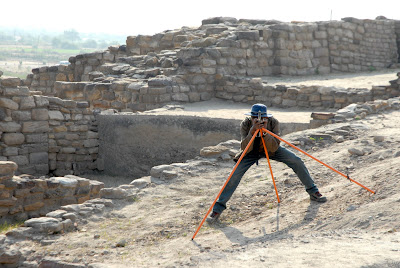Well, this is about a trip I took in February this year with my younger sister Priya who works for Times of India, Chennai. She had got a fellowship to study and report on man-elephant conflict in the Coimbatore region. So after a long long while, bro and sis got to spend some quality time together. We visited several areas of conflict in the region, including commercial farms and tribal villages. (Priya in action at a tribal village - pic above)
It was interesting to see that, while the tribals were well-adjusted to the idea that elephants would take a share of their crops and were happy with the harvest that remained, the commercial farmers were indignant and wanted the problem elephants removed/eliminated. Some of the more imaginative amongst them even alerted us about their pet theory that these elephants come from Kerala and are trained and sent in by the cunning Mallus from across the border who want to destroy Tamil crops! Also, the tribals tried to grow crops that were not attractive to the elephants while the farmers were growing cash crops that the elephants loved.
Priya's study also showed a lot of encroachments in the elephant corridors used by these behemoths to move around in their extended range. Since elephants are mega-herbivores that pretty much devastate the area they feed in, it is important that they move to other areas and give time to their former feeding grounds to recover from the effects of their foraging.
But the best part of our trip was the visit to the elephant training camp at the Indira Gandhi Wildlife Sanctuary at Anamalai and the contiguous Parambikulam National Park in Kerala. Apart from meeting up with a lot of wildlife experts like the famous Dr. Easa (formerly with Kerala Forest Research Institute) and the legendary vet Dr. Cherian, we got to see the keepers of the law in the elephant world - the kumki elephants of Anamalai!
The kumkis are the trained elephants that are used to drive back invading herds and tackle rogue elephants. They have to be strong in body and mind and must obey the commands of their mahout at all times. The most revered among them is Kaleem (in pic above) - at all of 45 years (older than me!), in his prime and the dominant male at the camp. He is a large-hearted soldier who is fearless in his encounters with wild elephants. However, he has also killed several of the other kumkis in the camp, including IG - the earlier alpha male.
As Kaleem's mahout Palanisamy narrated his great deeds and misdeeds to us and as we photographed him in the fading light, Kaleem struck several poses to impress us. He had a devilish twinkle in his eye and it was quite clear that he reveled in all the attention he was getting! And the enduring memory of this trip is just that - Kaleem, the Terrible, performing schoolboy pranks to get our attention, while the sun gradually set in the beautiful forested valley that is the location of the elephant training camp.


